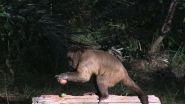(Press-News.org) CAMBRIDGE, Mass--Bombardier beetles, which exist on every continent except Antarctica, have a pretty easy life. Virtually no other animals prey on them, because of one particularly effective defense mechanism: When disturbed or attacked, the beetles produce an internal chemical explosion in their abdomen and then expel a jet of boiling, irritating liquid toward their attackers.
Researchers had been baffled by the half-inch beetles' ability to produce this noxious spray while avoiding any physical damage. But now that conundrum has been solved, thanks to research by a team at MIT, the University of Arizona, and Brookhaven National Laboratory. The findings are published this week in the journal Science by MIT graduate student Eric Arndt, professor of materials science and engineering Christine Ortiz, Wah-Keat Lee of Brookhaven National Laboratory, and Wendy Moore of the University of Arizona.
"Their defensive mechanism is highly effective," Arndt says, making bombardier beetles "invulnerable to most vertebrates, and invertebrates" -- except for a few very specialized predators that have developed countermeasures against the noxious spray.
The liquid these beetles eject is called benzoquinone, and is actually a fairly common defensive agent among insects, Arndt says. But bombardier beetles are unique in their ability to superheat the liquid and expel it in an intense, pulsating jet.
The key is that they synthesize the chemical at the instant of use, mixing two chemical precursors in a protective chamber in their hindquarters. As the materials combine to form the irritant, they also give off intense heat that brings the liquid almost to the boiling point -- and, in the process, generates the pressure needed to expel it in a jet.
Seeing inside a living beetle
"For decades, the complex mechanism of how the bombardier beetle achieves spray pulsation as a chemical defense has not been understood, because only external observations were used previously," Ortiz says. In the current study, the researchers used high-speed synchrotron X-ray imaging to "see" inside the abdomens of living bombardier beetles during explosions. They used a facility at Argonne National Laboratory to carry out the experiments and produce detailed images that revealed, for the first time, how the process works, with a camera recording the action at a rate of 2,000 frames per second.
The X-ray images of the explosion reveal the dynamics of vapor inside the beetles' abdomens. They show that spray pulsation is controlled by the passageway between two internal chambers; two structures control this process: a flexible membrane and a valve.
The opening and closing of this passageway between a chamber holding the precursor liquid and an explosion chamber seems to take place passively; an increase in pressure during the explosion expands the membrane, closing the valve. Then, after the pressure is released when the liquid is ejected, the membrane relaxes back to its original state and the passage reopens, allowing the next pulse to form. This all takes place so rapidly -- not to mention inside the insect -- that the process had never been directly observed.
The explosive mechanism used by the bombardier beetle generates a spray that is not only much hotter than that emitted by other insects that use the same chemical irritant, but also propels the jet five times faster. Both the speed and the heat serve to make the spray even more effective against potential predators, Arndt says.
The pulsing nature of the spray may help protect the structure of the beetle's reaction chamber, Arndt says, allowing time for the chamber walls to cool a bit before the next pulse.
Understanding the beetles' ability to survive these intense internal explosions may help in designing blast-protection systems; this study shows how the sophisticated and specialized biological design of the system works to simultaneously achieve defensive and protective functions, Ortiz says. The reaction chamber, for example, possesses a rigid, reinforcing structure to minimize stretching and sustain temperature increases during an explosion, while other components allow for controlled, reversible stretching and movement to control the jet of fluid. The dynamics of the spray generation might also provide information useful in the design of propulsion systems, the researchers say.
INFORMATION:
The vivid pigmentation of zebras, the massive jaws of sharks, the fight or flight instinct and the diverse beaks of Darwin's finches. These and other remarkable features of the world's vertebrates stem from a small group of powerful cells, called neural crest cells, but little is known about their origin.
Now Northwestern University scientists propose a new model for how neural crest cells, and thus vertebrates, arose more than 500 million years ago.
The researchers report that, unlike other early embryonic cells that have their potential progressively restricted as ...
ORANGE, Calif. - Researchers in Chapman University's Argyros School of Business and Economics and their collaborators have just published a study on the evolution of yoga in the marketplace. Assistant Professor Gokcen Coskuner-Balli, Ph.D., co-authored the study, which examined how the meaning of yoga transformed in the past three decades. The results show that yoga became decreasingly associated with spirituality and increasingly associated with medicine and fitness. The study argues that the shift in the meanings are due to the changes in how yoga gurus are trained, market ...
Flowering plants, also known as angiosperms, add an allure to the world that is unlike anything else in nature, but more importantly, they sustain us. Most of the fruits, vegetables, grains, beans, nuts, and even herbs and spices that we consume are produced by flowering plants. They all belong to the green plant branch of the tree of life, and a novel DNA analysis software program named MarkerMiner facilitates identification of genes that can be used to elucidate the evolutionary relationships between them.
University of Florida (UF) biologist Srikar Chamala, working ...
Over the past 35 years, California's high-wage workers have seen steady increases in their paychecks. But low-wage workers, 4.8 million strong and about one-third of the state's workforce, earned less in inflation-adjusted dollars in 2014 than they did in 1979, according to an analysis from the University of California, Berkeley.
UC Berkeley researchers analyzing U.S. Census Bureau data at the campus's Center for Labor Research and Education found that low-wage workers, defined as those earning hourly wages of $13.63 or less, have seen steady declines in their inflation-adjusted ...
As the number of bills passed by Congress declines, fewer and fewer Congressional representatives are voting across party lines, leaving only a few key representatives as collaborative voters, according to researchers.
"We can't say for sure that the decline in cooperation is the sole reason that there are fewer bills being introduced or passed by Congress, but we do know the two are statistically correlated, and both have been dropping steadily over the past 60 years," said Clio Andris, lead author and assistant professor of geography at Penn State.
The researchers ...
China's government and other sources say that the country's carbon-dioxide emissions flattened out between 2013 and 2014. The leveling-off was a remarkable feat that could set the country on a course to beating its own goals for lowering emissions. But this optimistic outcome hinges on China overcoming some serious energy challenges, according to an article in Chemical & Engineering News (C&EN), the weekly newsmagazine of the American Chemical Society.
Steven Gibb, a senior editor at C&EN, reports that a number of factors could help explain the emissions plateau. China ...
How and when does mom feed her embryo? We humans, like most mammals, experience pregnancy where a mother supplies nutrition directly to the embryo as it develops. But we're in the minority.
Most members of the animal kingdom supply eggs with nutritious yolk before they are fertilized. With this yolk supply, fertilized eggs develop as embryos in the environment outside the mother's body. For over a century, the scientific understanding of matrotrophy ("mother-feeding") of an embryo developing inside a mom's body has come from vertebrate animals, especially mammals like ...
The latest Special Issue from ecancermedicalscience is dedicated to the memory of our late friend, Dr Mario Sideri.
The Special Issue, "Prevention of gynaecological cancers: in memory of Mario Sideri," consists of nine articles centred around Dr Sideri's favoured research topic.
Dr Sideri was one of the first doctors in the world to identify the connection between the human papillomavirus (HPV) and cervical cancer.
He served as the Director of the Preventive Gynecology Unit at the European Institute of Oncology (IEO) in Milan from 1994 until his tragic death in June ...
When it comes to cracking nuts, wild bearded capuchin monkeys are more skilled than anyone had given them credit for, according to researchers who report new findings in the Cell Press journal Current Biology on April 30.
The monkeys are known to use stone "hammers" to crack nuts. The new study shows that the monkeys are quite careful about the amount of force delivered to those nuts. They adjust the force applied with each strike based on the condition of the nutshell, making it less likely that they'll end up smashing the tasty kernel inside.
"Wild bearded capuchin ...
Bats are masters of flight in the night sky, capable of steep nosedives and sharp turns that put our best aircraft to shame. Although the role of echolocation in bats' impressive midair maneuvering has been extensively studied, the contribution of touch has been largely overlooked. A study published April 30 in Cell Reports shows, for the first time, that a unique array of sensory receptors in the wing provides feedback to a bat during flight. The findings also suggest that neurons in the bat brain respond to incoming airflow and touch signals, triggering rapid adjustments ...

